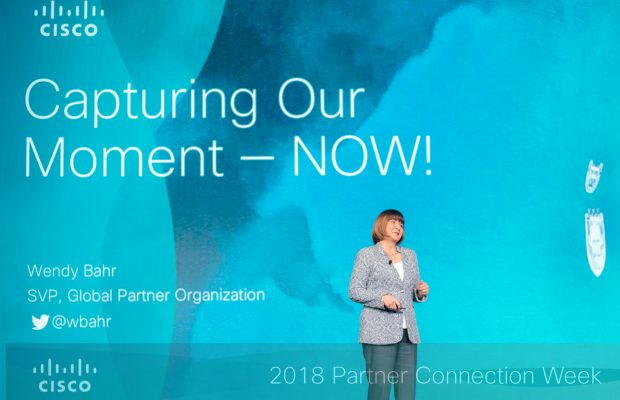THE BAHAMAS – It’s no secret the number of connected devices has been and will continue to rapidly grow for the foreseeable future. There are approximately eight and a half billion Internet of Things (IoT) devices connected globally as of 2017, and that number will rise dramatically to over 20 billion by 2020, according to Gartner.
With the explosion of devices, the old way of managing them – manually – has become unreasonable.
“Our customers are drowning in a sea of complexity; they need innovation and imagination to help them understand the art of the possible and get more value from their business. Cisco can provide that,” Nirav Sheth, vice president of solutions, architectures and engineering of Cisco’s global partner organization, says at the company’s Partner Connection Week 2018 in Nassau, The Bahamas.
Living up to its promises of innovation and imagination, Cisco is investing heavily into artificial intelligence (AI), integrating machine-learning (ML) capabilities into many of its products and services.
ML is fueled by data and it will catalyze edge devices even further, according to Ruba Borno, Cisco’s vice president of growth initiatives and chief of staff to the CEO, Chuck Robbins.
“AI is a huge opportunity for partners; in the next 10 years, 95 per cent of every new product and service will somehow incorporate AI,” explains Borno. “We’re expecting a 59 per cent growth in AI-enabled systems and 75 per cent of developer teams plan to use it in the next few years, so we’re fully embracing AI into our portfolio.”
For example, Cisco has integrated AI/ML to its network product, DNA Center, which uses aggregated data to look for both good and suboptimal network performances, and can detect a network outage hours – if not days – in advance. The platform understands context and intent based on the policies inputted by IT teams, and with over 43 per cent of IT time dedicated to troubleshooting, it’s a tool that can save many headaches.
“DNA Center is more than just a dashboard; it helps with operations, it addresses problems before they become problems, and it reduces manual steps in managing business networks,” Borno adds. “It also comes with built-in security. The ML in the platform helps detect malware in encrypted traffic without actually decrypting it, which is unique to the industry.”
Adapt or die: AI will disrupt the channel and change the role of the partner
With so many aspects of the network now becoming automated, the role of the partner will need to evolve to more than just a service provider.
“In the early days of AI, there was a concern amongst partners that if they didn’t provide manual services like setting up VLANs, what was their role? But that was years ago and things have changed,” Wendy Bahr, senior vice president of Cisco’s global partner organization, tells CDN. “Now, approximately 70 per cent of costs are operating networks, so if a customer can free up those costs through automation, that means they’ll have more money to reinvest in other services that a partner can provide.”
If anything, increased network automation because of AI actually opens more doors for partners, Bahr continues, because it lets them have more of an “intimate business conversation.”
Adding to this is Sheth, who says AI is resonating with Cisco partners.
“They’re excited for these discussions instead of apprehensive of how their roles will change in terms of serving their customers. They’re used to doing the heavy lifting, but they don’t necessarily have to anymore,” he explains. “We’re not suggesting they move past technical skills and become consultants. They will always have a role, but this gives them new opportunities to move up the value stack. In fact, we’re seeing partners that move up the value stack and specialize in digital services like this grow faster than anyone else, so it’s a smart business move.”
Partners on the fence
Canadian partners echo these sentiments. Daniel Reio, the director of product and partner management at CDW Canada, a Cisco reseller, says that AI enables the company to provide a better, more foundational network.
“During the last few years, we’ve seen Cisco prioritize other areas of its business over networking. Not that they were defocusing on enterprise networking – it’s a big portion of their business – but they brought out all these other pieces like cloud and security,” Reio tells CDN. “But they’ve made a statement this week validating the fact that the network is important again. Whether wired or wireless, networks are the foundation of everything, and AI is crucial to that.”
He continues to say that with the amount of data being created from devices and through networks, AI is necessary in “pulling it all together to build intelligence.”
“There’s so much data being created and the network will need to be as robust as it possible can to handle that flow,” Reio says. “Building AI into a robust network will help it function properly and help direct information to where it needs to go.”
On the flipside, even with all this potential, some partners are still not ready to jump onboard with AI. Long View Systems’ senior vice president of business development Kent MacDonald tells CDN that while he’s glad to see Cisco moving in this direction, his organization isn’t quite prepared to take AI services to the market just yet.
“Are we ready to take [AI] to market today? No, but I’m glad that [Cisco] is developing products and services like that,” he explains. “It falls into that big data and analytics space, which we know is where we have to get to. AI and big data will be very important for businesses going forward. To see Cisco developing the technology and the programs, its great and we’ll be able to jump into that initiative eventually.”
Cisco knows some partners will be hesitant or slow to adopt AI, but at the end of the day, they will need to adapt to survive.
“Everyone moves at difference paces and not everyone will get on board with cloud, analytics, or AI; they may decide to stay within a more traditional vein like security,” Bahr points out. “But we encourage our partners to change and evolve, because if they stand still, there is a risk of being left behind. Like the old saying goes, fix the roof when the sun is shining.”






